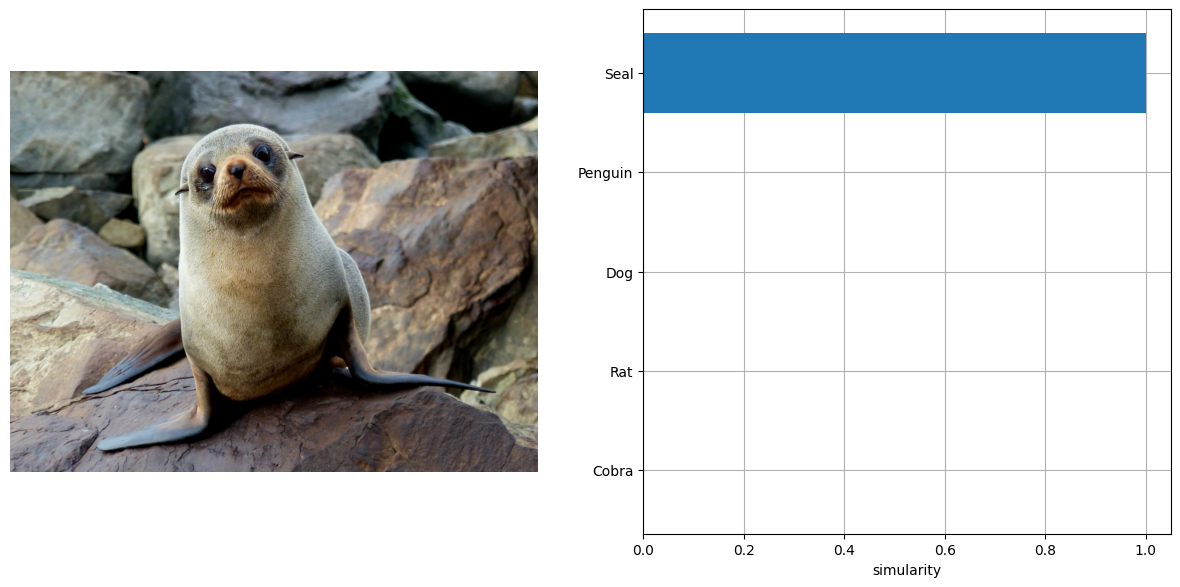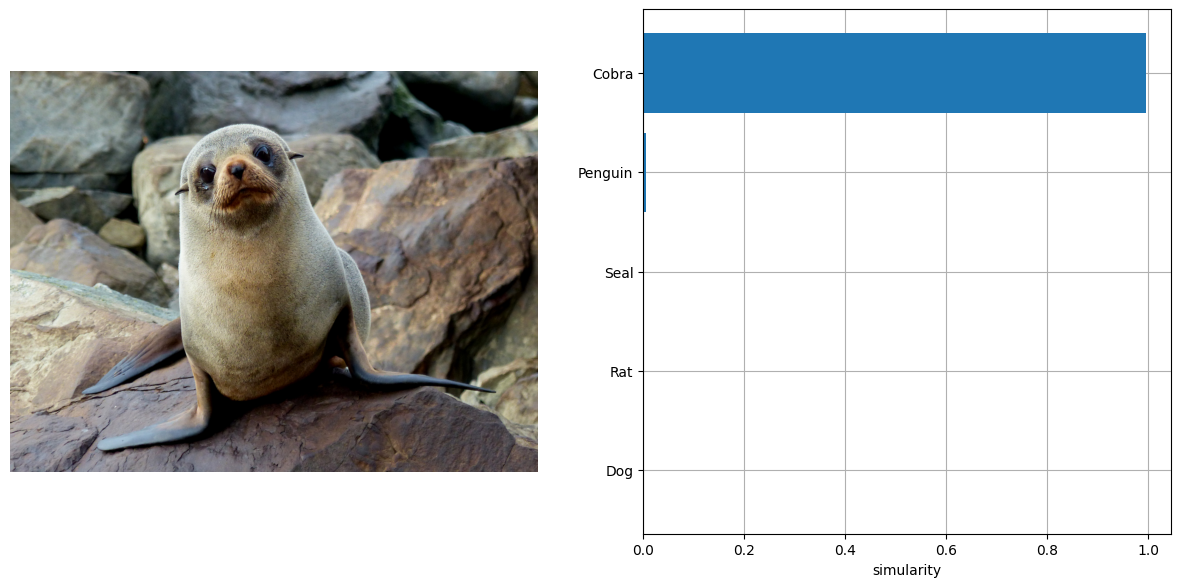Jina CLIP と OpenVINO を使用した CLIP モデル#
この Jupyter ノートブックは、ローカルへのインストール後にのみ起動できます。
jina-clip-v1 は、Jina AI によってトレーニングされた最先端の英語マルチモーダル (テキスト画像) 埋め込みモデルです。これは、テキスト間の検索には優れていても、クロスモーダル・タスクに対応していない従来のテキスト埋め込みモデルと、画像とテキストの埋め込みを効果的に調整できますがテキスト間の検索には最適化されていないモデル間のギャップを埋めます。jina-clip-v1 は、両方の領域で堅牢なパフォーマンスを提供します。この二重化された機能により、マルチモーダル検索拡張生成 (MuRAG) アプリケーションに最適なツールとなり、単一のモデル内でのシームレスな text-to-text 検索と、text-to-image 検索が可能になります。jina-clip-v1 は、テキストの説明による画像検索、マルチモーダル質問応答、マルチモーダル・コンテンツ生成など、さまざまなマルチモーダル・アプリケーションに使用できます。Jina AI は、jina-clip-v1 やその他の埋め込みモデルを操作するインターフェイスとして、Embeddings API も提供しています。
このノートブックでは、Hugging Face トランスフォーマーを使用してモデルを読み込み、OpenVINO IR 形式に変換し、NNCF を使用して最適化するデモを示します。
目次:
必要条件#
%pip install -q "openvino>=2024.2.0" "datasets>=2.20" "nncf>=2.11.0"
%pip install -q --extra-index-url https://download.pytorch.org/whl/cpu "gradio>=4.19" "pillow" "einops" "timm" "transformers[torch]>=4.39" "torch>=2.1"Note: you may need to restart the kernel to use updated packages.
Note: you may need to restart the kernel to use updated packages.モデルのインスタンス化#
jinaai/jina-clip-v1 に Hugging Face トランスフォーマーをロードします。AutoModel を使用して PyTorch モデルクラスのインスタンスを作成し、from_pretrained メソッドを使用してモデル構成と重みをロードして初期化します。
from transformers import AutoModel
model = AutoModel.from_pretrained("jinaai/jina-clip-v1", trust_remote_code=True)2024-07-13 00:37:54.543689: I tensorflow/core/util/port.cc:110] oneDNN custom operations are on.You may see slightly different numerical results due to floating-point round-off errors from different computation orders.To turn them off, set the environment variable TF_ENABLE_ONEDNN_OPTS=0. 2024-07-13 00:37:54.579011: I tensorflow/core/platform/cpu_feature_guard.cc:182] This TensorFlow binary is optimized to use available CPU instructions in performance-critical operations.To enable the following instructions: AVX2 AVX512F AVX512_VNNI FMA, in other operations, rebuild TensorFlow with the appropriate compiler flags. 2024-07-13 00:37:55.252367: W tensorflow/compiler/tf2tensorrt/utils/py_utils.cc:38] TF-TRT Warning: Could not find TensorRT
入力データを準備#
このモデルは、英語の文章をテキスト入力としてエンコードできます。画像は、ローカル・ファイル・パス、URL としてモデルに提供することも、PIL.Image オブジェクトを直接渡すこともできます。
from PIL import Image
import requests
# 画像入力データ
r = requests.get(
url="https://raw.githubusercontent.com/openvinotoolkit/openvino_notebooks/latest/utils/notebook_utils.py",
)
open("notebook_utils.py", "w").write(r.text)
from notebook_utils import download_file
download_file(
"https://github.com/openvinotoolkit/openvino_notebooks/assets/29454499/3f779fc1-c1b2-4dec-915a-64dae510a2bb",
"furseal.png",
directory="data",
)
img_furseal = Image.open("./data/furseal.png")
image_path = download_file(
"https://storage.openvinotoolkit.org/repositories/openvino_notebooks/data/data/image/coco.jpg",
directory="data",
)
img_coco = Image.open("./data/coco.jpg")
IMAGE_INPUTS = [img_furseal, img_coco]
# テキスト入力データ
TEXT_INPUTS = ["Seal", "Cobra", "Rat", "Penguin", "Dog"]data/furseal.png: 0%| | 0.00/2.55M [00:00<?, ?B/s]data/coco.jpg: 0%| | 0.00/202k [00:00<?, ?B/s]from typing import List
import matplotlib.pyplot as plt
import numpy as np
from PIL import Image
from scipy.special import softmax
def calc_simularity_softmax(embeddings1, embeddings2, apply_softmax=True):
simularity = []
for emb1 in embeddings1:
temp_simularity = []
for emb2 in embeddings2:
temp_simularity.append(emb1 @ emb2)
temp_simularity = softmax(temp_simularity) if apply_softmax else temp_simularity
simularity.append(temp_simularity)
return simularity
def visionize_result(image: Image, labels: List[str], probs: np.ndarray, top: int = 5):
"""
Utility function for visionization classification results
params:
image: input image
labels: list of classification labels
probs: model predicted softmaxed probabilities for each label
top: number of the highest probability results for visionization
returns:
None
"""
plt.figure(figsize=(64, 64))
top_labels = np.argsort(-probs)[: min(top, probs.shape[0])]
top_probs = probs[top_labels]
plt.subplot(8, 8, 1)
plt.imshow(image)
plt.axis("off")
plt.subplot(8, 8, 2)
y = np.arange(top_probs.shape[-1])
plt.grid()
plt.barh(y, top_probs)
plt.gca().invert_yaxis()
plt.gca().set_axisbelow(True)
plt.yticks(y, [labels[index] for index in top_labels])
plt.xlabel("simularity")jina-clip モデルからトークナイザーと前処理を使用します。model.get_tokenizer() を使用してテキスト入力データをエンコードするのにトークナイザーを使用し、model.get_preprocess() を使用して画像データの前処理を行います。
tokenizer = model.get_tokenizer()
tokenizer_kwargs = dict()
tokenizer_kwargs["padding"] = "max_length"
tokenizer_kwargs["max_length"] = 512
tokenizer_kwargs["truncation"] = True
text_inputs = tokenizer(
TEXT_INPUTS,
return_tensors="pt",
**tokenizer_kwargs,
).to("cpu")
processor = model.get_preprocess()
vision_inputs = processor(images=IMAGE_INPUTS, return_tensors="pt")PyTorch モデル推論を実行#
text_embeddings = model.text_model(text_inputs["input_ids"])
image_embeddings = model.vision_model(vision_inputs["pixel_values"])
res = calc_simularity_softmax(image_embeddings.detach().numpy(), text_embeddings.detach().numpy())
visionize_result(img_furseal, TEXT_INPUTS, np.array(res[0]))
OpenVINO モデル推論を実行#
モデルを OpenVINO IR 形式に変換#
OpenVINO は、OpenVINO 中間表現 (IR) への変換により PyTorch モデルをサポートします。これには、OpenVINO モデル・トランスフォーメーション API を使用する必要があります。ov.convert_model 関数は、元の PyTorch モデル・インスタンスとトレース用のサンプル入力を受け取り、OpenVINO フレームワークでこのモデルを表す ov.Model を返します。変換されたモデルは、ov.save_model 関数を使用してディスクに保存するか、core.complie_model を使用してデバイスに直接ロードできます。
import openvino as ov
from pathlib import Path
core = ov.Core()fp16_text_model_path = Path("jina-clip-text_v1_fp16.xml")
if not fp16_text_model_path.exists():
ov_text_model = ov.convert_model(model.text_model, example_input=text_inputs["input_ids"])
ov.save_model(ov_text_model, fp16_text_model_path)WARNING:tensorflow:Please fix your imports.Module tensorflow.python.training.tracking.base has been moved to tensorflow.python.trackable.base.The old module will be deleted in version 2.11.WARNING:tensorflow:Please fix your imports. Module tensorflow.python.training.tracking.base has been moved to tensorflow.python.trackable.base. The old module will be deleted in version 2.11. /opt/home/k8sworker/ci-ai/cibuilds/ov-notebook/OVNotebookOps-727/.workspace/scm/ov-notebook/.venv/lib/python3.8/site-packages/transformers/modeling_utils.py:4565: FutureWarning: _is_quantized_training_enabled is going to be deprecated in transformers 4.39.0.Please use model.hf_quantizer.is_trainable instead warnings.warn( /opt/home/k8sworker/.cache/huggingface/modules/transformers_modules/jinaai/jina-bert-flash-implementation/b78d1595de294f13ffe7b19d6cd63892a6e4e7a4/mha.py:333: TracerWarning: Converting a tensor to a Python float might cause the trace to be incorrect. We can't record the data flow of Python values, so this value will be treated as a constant in the future.This means that the trace might not generalize to other inputs! softmax_scale = self.softmax_scale or 1.0 / math.sqrt(q.shape[-1]) /opt/home/k8sworker/.cache/huggingface/modules/transformers_modules/jinaai/jina-bert-flash-implementation/b78d1595de294f13ffe7b19d6cd63892a6e4e7a4/mha.py:343: TracerWarning: Converting a tensor to a Python boolean might cause the trace to be incorrect.We can't record the data flow of Python values, so this value will be treated as a constant in the future.This means that the trace might not generalize to other inputs! if seqlen > self.linear_biases.shape[-1]:
fp16_vision_model_path = Path("jina-clip-vision_v1_fp16.xml")
if not fp16_vision_model_path.exists():
ov_vision_model = ov.convert_model(model.vision_model, example_input=vision_inputs["pixel_values"])
ov.save_model(ov_vision_model, fp16_vision_model_path)/opt/home/k8sworker/.cache/huggingface/modules/transformers_modules/jinaai/jina-clip-implementation/952897b38094b9f6a47b3d9a1d8239523e374098/eva_model.py:468: TracerWarning: Converting a tensor to a Python boolean might cause the trace to be incorrect.We can't record the data flow of Python values, so this value will be treated as a constant in the future.This means that the trace might not generalize to other inputs!
assert H == self.img_size[0] and W == self.img_size[1], (推論デバイスの選択#
ワークを開始するには、ドロップダウン・リストから推論デバイスを選択します。
import ipywidgets as widgets
device = widgets.Dropdown(
options=core.available_devices + ["AUTO"],
value="AUTO",
description="Device:",
disabled=False,
)
deviceDropdown(description='Device:', index=1, options=('CPU', 'AUTO'), value='AUTO')モデルをコンパイルして推論を実行#
compiled_text_model = core.compile_model(fp16_text_model_path, device.value)
compiled_vision_model = core.compile_model(fp16_vision_model_path, device.value)text_ov_res = compiled_text_model(text_inputs["input_ids"])
vis_ov_res = compiled_vision_model(vision_inputs["pixel_values"])
res = calc_simularity_softmax(vis_ov_res[0], text_ov_res[0])
visionize_result(img_furseal, TEXT_INPUTS, np.array(res[0]))
NNCF を使用してモデルを INT8 に量子化#
NNCF (Neural Network Compression Framework) から 8 ビットのトレーニング後の量子化を適用してモデルを高速化し、OpenVINO™ ツールキットを介して量子化されたモデルを推論します。NNCF は、量子化レイヤーをモデルグラフに追加し、トレーニング・データセットのサブセットを使用してこれらの追加の量子化レイヤーのパラメーターを初期化することで、トレーニング後の量子化を可能にします。量子化操作は FP32/FP16 ではなく INT8 で実行されるため、モデル推論が高速化されます。最適化プロセスには次の手順が含まれます:
量子化データセットを準備
nncf.quantize()を使用して変換された OpenVINO モデルを NNCF で量子化します。openvino.save_model()関数を使用してINT8モデルを保存します。変換および量子化されたモデルのモデルサイズを比較します。
変換および量子化されたモデルのパフォーマンスを比較します。
注: 量子化プロセスを実行するには、さらに時間とメモリーが必要になる場合があります。以下のウィジェットで無効化できます:
to_quantize = widgets.Checkbox(
value=True,
description="Quantization",
disabled=False,
)
to_quantizeCheckbox(value=True, description='Quantization')# `skip_kernel_extension` モジュールを取得
r = requests.get(
url="https://raw.githubusercontent.com/openvinotoolkit/openvino_notebooks/latest/utils/skip_kernel_extension.py",
)
open("skip_kernel_extension.py", "w").write(r.text)
%load_ext skip_kernel_extensionデータセットの準備#
キャプションのアノテーションが付けられた約 330 万個の画像で構成される Conceptual Captions データセットは、モデルの量子化に使用されます。
テキストデータを含むデータセット#
%%skip not $to_quantize.value
import torch
from datasets import load_dataset
from tqdm.notebook import tqdm
import requests
from io import BytesIO
import numpy as np
from PIL import Image
from requests.packages.urllib3.exceptions import InsecureRequestWarning
requests.packages.urllib3.disable_warnings(InsecureRequestWarning)
def check_text_data(data):
"""
Check if the given data is text-based.
"""
if isinstance(data, str):
return True
if isinstance(data, list):
return all(isinstance(x, str) for x in data)
return False
}
def collate_fn_text(example, text_column="caption"):
"""
Preprocesses an example by loading and transforming text data.
Checks if the text data in the example is valid by calling the `check_text_data` function.
If there is any error during the download process, returns None.
Returns the preprocessed inputs with transformed image and text data.
"""
assert len(example) == 1
example = example[0]
if not check_text_data(example[text_column]):
raise ValueError("Text data is not valid")
text_input = tokenizer(
example[text_column],
return_tensors='pt',
**tokenizer_kwargs)
return text_input
def prepare_calibration_data_text(dataloader, init_steps):
"""
This function prepares calibration data from a dataloader for a specified number of initialization steps.
It iterates over the dataloader, fetching batches and storing the relevant data.
"""
data = []
print(f"Fetching {init_steps} samples for the initialization...")
with tqdm(total=init_steps) as pbar:
for batch in dataloader:
if len(data) == init_steps:
break
if batch:
pbar.update(1)
with torch.no_grad():
data.append(batch["input_ids"].to("cpu"))
return data%%skip not $to_quantize.value
import logging
import nncf
dataset = load_dataset("google-research-datasets/conceptual_captions", trust_remote_code=True)
train_dataset = dataset["train"].shuffle(seed=42)
dataloader_text = torch.utils.data.DataLoader(train_dataset, collate_fn=collate_fn_text, batch_size=1)
calibration_data_text = prepare_calibration_data_text(dataloader_text, 50)INFO:nncf:NNCF initialized successfully. Supported frameworks detected: torch, tensorflow, onnx, openvino Fetching 50 samples for the initialization...0%| | 0/50 [00:00<?, ?it/s]画像データを含むデータセット#
%%skip not $to_quantize.value
def get_pil_from_url(url):
"""
Downloads and converts an image from a URL to a PIL Image object.
"""
response = requests.get(url, verify=False, timeout=20)
image = Image.open(BytesIO(response.content))
return image.convert("RGB")
def collate_fn_vision(example, image_column="image_url"):
"""
Preprocesses an example by loading and transforming image data.
Downloads the image specified by the URL in the image_column by calling the `get_pil_from_url` function.
If there is any error during the download process, returns None.
Returns the preprocessed inputs with transformed image and text data.
"""
assert len(example) == 1
example = example[0]
url = example[image_column]
try:
image = get_pil_from_url(url)
h, w = image.size
if h == 1 or w == 1:
return None
except Exception:
return None
vision_input = processor(images=[image])
return vision_input
def prepare_calibration_data_vis(dataloader, init_steps):
"""
This function prepares calibration data from a dataloader for a specified number of initialization steps.
It iterates over the dataloader, fetching batches and storing the relevant data.
"""
data = []
print(f"Fetching {init_steps} samples for the initialization...")
with tqdm(total=init_steps) as pbar:
for batch in dataloader:
if len(data) == init_steps:
break
if batch:
pbar.update(1)
with torch.no_grad():
data.append(batch["pixel_values"].to("cpu"))
return data%%skip not $to_quantize.value
dataset = load_dataset("google-research-datasets/conceptual_captions", trust_remote_code=True)
train_dataset = dataset["train"].shuffle(seed=42)
dataloader_vis = torch.utils.data.DataLoader(train_dataset, collate_fn=collate_fn_vision, batch_size=1)
calibration_data_vision = prepare_calibration_data_vis(dataloader_vis, 50)Fetching 50 samples for the initialization...0%| | 0/50 [00:00<?, ?it/s]量子化を行います#
事前トレーニングされた FP16 モデルから量子化モデルを作成します。
注: 量子化は時間とメモリーを消費する操作です。以下の量子化コードを実行すると、時間がかかる場合があります。
テキストモデルの量子化#
int8_text_model_path = "jina-clip-text_v1_int8.xml"%%skip not $to_quantize.value
if len(calibration_data_text) == 0:
raise RuntimeError(
'Calibration dataset is empty.Please check internet connection and try to download images manually.' )
ov_model_text = core.read_model(fp16_text_model_path)
calibration_dataset = nncf.Dataset(calibration_data_text)
quantized_model = nncf.quantize(
model=ov_model_text,
calibration_dataset=calibration_dataset
)
ov.save_model(quantized_model, int8_text_model_path)Output()Output()画像モデルの量子化#
int8_vision_model_path = "jina-clip-vision_v1_int8.xml"%%skip not $to_quantize.value
if len(calibration_data_vision) == 0:
raise RuntimeError(
'Calibration dataset is empty.Please check internet connection and try to download images manually.' )
ov_model_vision = core.read_model(fp16_vision_model_path)
calibration_dataset = nncf.Dataset(calibration_data_vision)
quantized_model = nncf.quantize(
model=ov_model_vision,
calibration_dataset=calibration_dataset
)
ov.save_model(quantized_model, int8_vision_model_path)Output()Output()%%skip not $to_quantize.value
compiled_text_model_int8 = core.compile_model(int8_text_model_path, device.value)
compiled_vision_model_int8 = core.compile_model(int8_vision_model_path, device.value)
text_ov_res_int8 = compiled_text_model_int8(text_inputs["input_ids"])
vis_ov_res_int8 = compiled_vision_model_int8(vision_inputs["pixel_values"])
res = calc_simularity_softmax(vis_ov_res_int8[0], text_ov_res_int8[0])
visionize_result(img_furseal, TEXT_INPUTS, np.array(res[0]))
ファイルサイズの比較#
%%skip not $to_quantize.value
from pathlib import Path
fp16_ir_model_size = Path(fp16_text_model_path).with_suffix(".bin").stat().st_size / 1024 / 1024
quantized_model_size = Path(int8_text_model_path).with_suffix(".bin").stat().st_size / 1024 / 1024
print(
f"Text model: FP16 model size - {fp16_ir_model_size:.2f} MB; INT8 model size - {quantized_model_size:.2f} MB; Model compression rate: {fp16_ir_model_size / quantized_model_size:.3f}"
)
fp16_ir_model_size = Path(fp16_vision_model_path).with_suffix(".bin").stat().st_size / 1024 / 1024
quantized_model_size = Path(int8_vision_model_path).with_suffix(".bin").stat().st_size / 1024 / 1024
print(
f"Vision model: FP16 model size - {fp16_ir_model_size:.2f} MB; INT8 model size - {quantized_model_size:.2f} MB; Model compression rate: {fp16_ir_model_size / quantized_model_size:.3f}"
)Text model: FP16 model size - 266.88 MB; INT8 model size - 136.98 MB; Model compression rate: 1.948
Vision model: FP16 model size - 163.83 MB; INT8 model size - 82.64 MB; Model compression rate: 1.983FP16 IR と量子化モデルの推論時間を比較#
FP16 と INT8 モデルの推論パフォーマンスを測定するには、キャリブレーション・データセットの推論時間の中央値を使用します。したがって、動的量子化モデルの速度向上を見積もることができます。
注: 最も正確なパフォーマンス推定を行うには、他のアプリケーションを閉じた後、ターミナル/コマンドプロンプトで
benchmark_appを実行することを推奨します。
%%skip not $to_quantize.value
import time
def calculate_inference_time(model_path, calibration_data):
model = core.compile_model(model_path, device.value)
inference_time = []
for batch in calibration_data:
start = time.perf_counter()
_ = model(batch)[0]
end = time.perf_counter()
delta = end - start
inference_time.append(delta)
return np.median(inference_time)%%skip not $to_quantize.value
fp16_latency = calculate_inference_time(fp16_text_model_path, calibration_data_text)
int8_latency = calculate_inference_time(int8_text_model_path, calibration_data_text)
print(f"Performance speed up for text model: {fp16_latency / int8_latency:.3f}")
fp16_latency = calculate_inference_time(fp16_vision_model_path, calibration_data_vision)
int8_latency = calculate_inference_time(int8_vision_model_path, calibration_data_vision)
print(f"Performance speed up for vision model: {fp16_latency / int8_latency:.3f}")Performance speed up for text model: 1.539
Performance speed up for vision model: 1.509Gradio デモ#
ゼロショット分類用に、独自の画像とカンマで区切ったラベルのリストを提供できます。
ファイル・アップロード・ウィンドウを使用して画像をアップロードし、テキストフィールドにラベル名を入力します。区切り文字としてカンマを使用します (例: cat、dog、bird)
import gradio as gr
core = ov.Core()
compiled_text_model_int8 = None
compiled_vision_model_int8 = None
if Path(int8_text_model_path).exists and Path(int8_vision_model_path).exists:
compiled_text_model_int8 = core.compile_model(int8_text_model_path, device.value)
compiled_vision_model_int8 = core.compile_model(int8_vision_model_path, device.value)
compiled_text_model_f16 = core.compile_model(fp16_text_model_path, device.value)
compiled_vision_model_f16 = core.compile_model(fp16_vision_model_path, device.value)
def image_text_sim(text, image, quantized_model):
compiled_text_model = compiled_text_model_int8 if quantized_model else compiled_text_model_f16
text = text.split(",")
text_inputs = tokenizer(text, return_tensors="pt", **tokenizer_kwargs)
emb1_res = compiled_text_model(text_inputs["input_ids"])
compiled_vision_model = compiled_vision_model_int8 if quantized_model else compiled_vision_model_f16
vision_input = processor(images=[image])
emb2_res = compiled_vision_model(vision_input["pixel_values"])
text_description = "Simularity: "
simularity = calc_simularity_softmax(emb2_res[0], emb1_res[0], False)
if len(text) == 1:
text_description += f"{simularity[0]}"
else:
simularity_text = "\n".join([f"{text[i]} {sim:.4f}" for i, sim in enumerate(simularity[0])])
text_description += f"\n{simularity_text}"
return text_description
def text_text_sim(text1, text2, quantized_model):
compiled_text_model = compiled_text_model_int8 if quantized_model else compiled_text_model_f16
text_inputs = tokenizer(text1, return_tensors="pt", **tokenizer_kwargs)
emb1_res = compiled_text_model(text_inputs["input_ids"])
text_inputs = tokenizer(text2, return_tensors="pt", **tokenizer_kwargs)
emb2_res = compiled_text_model(text_inputs["input_ids"])
return f"Simularity: {calc_simularity_softmax(emb1_res[0], emb2_res[0], False)[0][0]:.4f}"
def image_image_sim(image1, image2, quantized_model):
compiled_vision_model = compiled_vision_model_int8 if quantized_model else compiled_vision_model_f16
vision_input = processor(images=[image1])
emb1_res = compiled_vision_model(vision_input["pixel_values"])
vision_input = processor(images=[image2])
emb2_res = compiled_vision_model(vision_input["pixel_values"])
return f"Simularity: {calc_simularity_softmax(emb1_res[0], emb2_res[0], False)[0][0]:.4f}"
with gr.Blocks() as demo:
gr.Markdown("Discover simularity of text or image files using this demo.")
model_choice_visible = Path(int8_text_model_path).exists and Path(int8_vision_model_path).exists
quantized_model = gr.Checkbox(
label="Use quantized int8 model", info="Model type.FP16 model is used by default.", visible=model_choice_visible, value=False
)
with gr.Tab("Text-Image"):
with gr.Row():
image_text_vis = gr.Image(label="Image", type="pil")
text_text_vis = gr.Textbox(label="Labels", info="Use comma to separate sentences") text_image_button = gr.Button("Submit")
with gr.Row():
gr.Examples([img_furseal], image_text_vis)
gr.Examples(["seal,rat,cobra"], text_text_vis)
text_image_output = gr.Textbox(label="Results")
with gr.Tab("Text-Text"):
with gr.Row():
text_text_1 = gr.Textbox(label="Text")
text_text_2 = gr.Textbox(label="Text")
text_text_button = gr.Button("Submit")
with gr.Row():
gr.Examples(["The breeding season for fur seals is from May to the end of November"], text_text_1)
gr.Examples(["Fur seals feed on fish and squid"], text_text_2)
text_text_output = gr.Textbox(label="Results")
with gr.Tab("Image-Image"):
with gr.Row():
image_image_1 = gr.Image(label="Image", type="pil")
image_image_2 = gr.Image(label="Image", type="pil")
image_image_button = gr.Button("Submit")
text_output = gr.Textbox(label="Results")
with gr.Row():
gr.Examples([img_furseal], image_image_1)
gr.Examples([img_coco], image_image_2)
image_image_output = gr.Textbox(label="Results")
text_image_button.click(image_text_sim, inputs=[text_text_vis, image_text_vis, quantized_model], outputs=text_image_output)
text_text_button.click(text_text_sim, inputs=[text_text_1, text_text_2, quantized_model], outputs=text_text_output)
image_image_button.click(image_image_sim, inputs=[image_image_1, image_image_2, quantized_model], outputs=image_image_output)
if __name__ == "__main__":
try:
demo.queue().launch(debug=False)
except Exception:
demo.queue().launch(share=True, debug=False)
# リモートで起動する場合は、server_name と server_port を指定
# demo.launch(server_name='your server name', server_port='server port in int')
# 詳細はドキュメントをご覧ください: https://gradio.app/docs/ローカル URL で実行中: http://127.0.0.1:7860 パブリックリンクを作成するには、launch() で share=True を設定します。